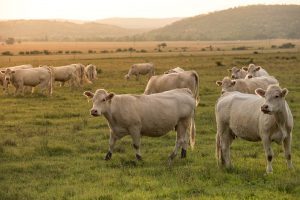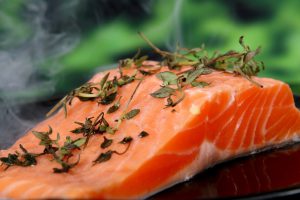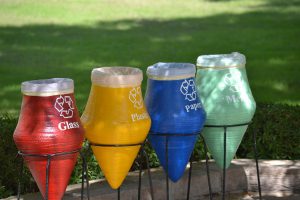When you think of humans’ impact on the environment, what do you think of? All the cars in your city spewing out carbon dioxide? All the phones charging, lights left on, and long, hot showers going on around you? How about the milk in your fridge, the fruit for your afternoon snack, the burgers being served at your local diner, or even the rice from your Chinese takeout? Turns out, that’s actually what you should be thinking of: the world’s food system is responsible for around a quarter of the greenhouse gases that humans generate each year. That’s because whatever it is you choose to put on your table, there is an entire system that goes into getting it to your fork, from raising and harvesting animals and plants, to processing, packaging and shipping food to markets to be sold.
But if it sounds disheartening that a full quarter of greenhouse gases are produced by something so necessary (I mean, we have to eat, right?), don’t be discouraged! Flip the script and think of it this way: if we all make even a few different choices when it comes to what we eat (and what we don’t eat), we can begin to make a difference in the fight against climate change. So, to that end, you should know how food impacts the environment and what changes you can make to reduce that impact.
Cow Farts Are a Real Problem
Now that we’ve got your attention, we’ll explain how meat in particular is a huge contributor to climate change: meat and dairy, especially from cows, accounts for around 14.5% of the world’s greenhouse gases every year. That’s roughly the same amount as the emissions from all the cars, trucks, airplanes and ships combined in the world! Why is meat such a big issue? Well, two reasons:

- Inefficient use of resources – When you think about it, it makes sense: it’s far less efficient to produce plants and then feed them to animals and then feed those animals to humans than it is to simply produce plants for humans to eat. Raising animals for food simply sucks up more resources: it takes a whole lot more land, energy, and water to produce a pound of animal protein than it does to produce a pound of plant protein, and, according to the United Nations Food and Agricultural Organization, it takes on average around 3 pounds of grain to produce 1 pound of meat.
- Methane production – Now we come to the cow farts! The reason that beef and lamb are the worst contributors of greenhouse gases is that the stomachs of cows and sheep contain bacteria that help them digest the grass and other foods that they eat, and that bacteria contains methane, which these animals release into the atmosphere through burps and flatulence. Methane emissions, including from these gassy animals, along with other things, like manure and rice paddies, account for 10% of all greenhouse gases.
What can you do to help reduce the impact of meat on the environment? Well, you might have guessed the easiest answer: cut meat out of your diet. Multiple studies have shown that switching to a vegetarian diet could help reduce our carbon footprints by a third, and going vegan would help even more. But it is a bit more complicated than that: meat production does provide livelihoods for a lot of people, and manure is great for fertilizer, plus not everyone is willing to go vegetarian or vegan.
Can You Still Eat That Meat (or Dairy)?
So, if you’re not willing to completely cut out meat, your best option is to cut out beef and switch to pork or poultry, or at least cut down on red meat. Consider this: eating beef once or twice a week (specifically, eating 75g, or about the amount of a fast food hamburger, once or twice a week) contributes 604kg to your annual greenhouse emissions, which is equivalent to driving 1,542 miles, heating your home for 95 days, or taking a round-trip flight from New York to New Orleans. In comparison, eating the same amount of pork contributes 140kg of greenhouse gases, and the same amount of chicken contributes 106kg.
All in all, if the average American replaced a third of the beef they eat with pork, poultry or legumes, food-related emissions would fall by around 13 percent. Put another way, The Natural Resources Defense Fund estimates that if all Americans eliminated just one quarter pound serving of beef per week, the reduction in global warming gas emissions would be equivalent to taking four to six million cars off the road. Experts agree that, for the health of your body and the planet, if you must eat meat, you should make it a side dish, not the main attraction. Even better? Cut out as much meat as you can, and go with alternate forms of protein, like beans, nuts, and protein-rich grains like quinoa.
And how about dairy? Well, milk and other milk-based dairy products do tend to have a lower carbon footprint than chicken, eggs, or pork per pound, except for certain cheese like cheddar and mozzarella, which can have a bigger footprint because they can take as much as 10 pounds of milk to make one pound of cheese. If you choose to go the non-dairy milk route, soy (as long as it’s sustainably farmed) or oat seem to be the earth-friendliest options, as they require less water to produce than almond or rice milk. As for fish as a source of protein, it can definitely be a better choice than meat, especially red meat, but you need to be careful what type you choose. Though open-ocean fishing fleets depend entirely on dirty fossil fuels, emitting an estimated 130 million tons of CO2 each year, wild caught fish like anchovies, sardines, herring, tuna, pollock, cod, and haddock have, on average, a lower carbon footprint than chicken or pork. Just make sure to choose fish that is not only wild caught, but certified sustainable – we’re currently already catching about as much wild fish as possible, so it’s important to buy sustainably harvested fish. Your best bets for low carbon-footprint seafood: wild-caught small fish like sardines or anchovies, or mollusks, which are often low-carbon even when farmed.
As for fish as a source of protein, it can definitely be a better choice than meat, especially red meat, but you need to be careful what type you choose. Though open-ocean fishing fleets depend entirely on dirty fossil fuels, emitting an estimated 130 million tons of CO2 each year, wild caught fish like anchovies, sardines, herring, tuna, pollock, cod, and haddock have, on average, a lower carbon footprint than chicken or pork. Just make sure to choose fish that is not only wild caught, but certified sustainable – we’re currently already catching about as much wild fish as possible, so it’s important to buy sustainably harvested fish. Your best bets for low carbon-footprint seafood: wild-caught small fish like sardines or anchovies, or mollusks, which are often low-carbon even when farmed.
Your Mom Was Right About Wasting Food
Eating too much of certain types of foods can be a problem, but so can not eating your food; or, specifically, buying food and not eating it. Food waste accounts for a huge 6% of all greenhouse gas emissions, because, astoundingly, a quarter of all calories produced in the world are thrown away, with Americans specifically trashing 20% of the food they buy. That means all the energy and water that went into producing your food was wasted, and, when it ends up in a landfill, it releases methane into the environment.
Food waste is usually unintentional (unless you’re a toddler, and then it seems to be an artform), but it’s important to find ways to keep it at bay. Ways to do this include:

- Planning your meals for the week, and only buying the ingredients you need (or, if you’re planning to order takeout, don’t order more than you need).
- Being honest with yourself about leftovers – if you aren’t going to eat them within a few days, freeze them!
- Remembering that those “sell by” dates on your food are really about food quality, not food safety, so don’t chuck things out just because that date has passed.
- Trying out composting – you can even do it in the city with a small bin in any outdoor area.
- Looking into companies that sell surplus foods or “ugly” produce to help rescue foods that would otherwise go to waste.
What a Long, Strange Trip It’s Been
Have you ever heard the term “food miles?” It refers to the distance of transporting food, such as by plane, boat, or truck, multiplied by the quantity of food transported by mass. Research shows that about 0.2% of food miles come from air travel, nearly 60% come from travel by sea, and approximately 31% are by road. That being said, because of the relatively small amount of food being transported such a long distance, transporting food by air emits 50 times as many greenhouse gases as transporting the same amount by sea, and five times as much as by road. So that means perishable foods that are produced internationally, which are typically transported by air, have a much, much higher carbon footprint than other foods.
While transportation only accounts for 6% of food’s climate footprint, it’s still a great idea to consider how far – and more importantly, by what method of transportation – your food is traveling. Consider that, in California alone, which imports food that is distributed around the nation, the emissions from importing fruits and vegetables is equivalent to the annual emissions from 1.5 million cars. So, you can also reduce the impact of your food by:
- Shopping locally at farmers’ markets
- Eating seasonal products when they are in season! The worst culprits in terms of climate footprint are things like cherries, blueberries, blackberries, and asparagus bought in the winter, because these perishable fruits are generally transported by air to their destinations.
- Grocery shopping less frequently
Plastic, Plastic Everywhere
Finally, no look at the impact of what we consume would be complete without a look at how these products are sold to us. While packaging only accounts for 5% of global food-related emissions, it does account for some serious damage to the environment: the average American creates 270 pounds of plastic waste each year, meaning more than 5 billion tons of plastic has ended up in landfills or as litter in the natural environment (including the ocean). It takes about 450 years for a plastic bottle to degrade fully, and what’s worse, while plastic is degrading, it becomes microplastics, which are currently spread all through our oceans and ending up in the bellies of sea creatures.
To do your part in combating plastic waste:
- Recycle – Only 9% of the plastic ever produced has been recycled; if you must buy food or drinks packaged in plastic, make sure to recycle (and recycle correctly – check your local regulations).
- Reuse – Use reusable shopping bags, or even reuse your plastic ones; studies show that paper shopping bags are actually worse from an emissions standpoint than plastic ones!
- Upcycle – If you can’t eliminate single-use packaging, try to eliminate the concept of single-use. Find creative ways to upcycle plastic packaging – you can try anything from reusing plastic jars for food storage to creating things like coasters and handbags!
What we eat and drink is a huge part of our lives – and rightly so! But what’s also important? The health of our planet. It can sometimes feel difficult to find a balance between enjoying the former and taking care of the latter, but if you know the facts, you can make informed choices, and have a positive impact on our environment!

